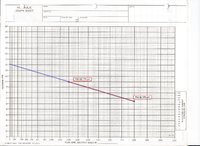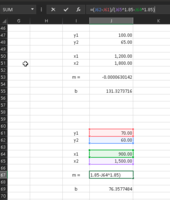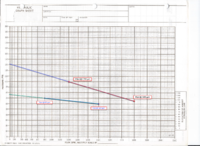Dear Forum.
I hope I have posted this in the correct section; it’s a long time since I took maths and even back then I wouldn’t have covered this. If I have posted this in the incorrect forum area, apologies; please advise where may be suitable.
I have a graph type which is used in my industry (fire protection) for graphing water supplies. It is considered a N1.85 Graph. It is semi-log (10xN1.85). The flow (x-axis) is logarithmic. The scale of distances between the increments increases. The rate of increase is the value to the power of 1.85 less the preceding value. (see table below with column in yellow showing sample of the increase rate in width).
Please see below sample of an actual graph. On the graph I have inserted two points sample points and have a line joining them. The sample points are (a) 100psi (y-axis) @ 1,200 gpm (x-axis) and (b) 65psi (y-axis) @ 1,800 gpm (x-axis).
I’m trying to find a formula that will tell me where this line would intercept on the y axis with 0 pressure. i.e. how much pressure would there be at no flow.

In the sample graph above I have drawn a line in red between the two know points and have drawn a light blue line to visually extrapolate as I'm looking for a formula to solve. In this sample the answer would be approx 132 (PSI) (at 0 flow).
Any help in this regard would be greatly appreciated!
I hope I have posted this in the correct section; it’s a long time since I took maths and even back then I wouldn’t have covered this. If I have posted this in the incorrect forum area, apologies; please advise where may be suitable.
I have a graph type which is used in my industry (fire protection) for graphing water supplies. It is considered a N1.85 Graph. It is semi-log (10xN1.85). The flow (x-axis) is logarithmic. The scale of distances between the increments increases. The rate of increase is the value to the power of 1.85 less the preceding value. (see table below with column in yellow showing sample of the increase rate in width).
First increment | to ^1.85 | less preceding value (width) |
1 | 1 | 1 |
2 | 3.60500185 | 2.60500185 |
3 | 7.632631955 | 4.027630104 |
4 | 12.99603834 | 5.363406387 |
5 | 19.63787576 | 6.641837414 |
6 | 27.51565232 | 7.877776565 |
7 | 36.59581083 | 9.080158512 |
8 | 46.85074227 | 10.25493144 |
9 | 58.25707056 | 11.40632829 |
10 | 70.79457844 | 12.53750788 |
11 | 84.44549146 | 13.65091302 |
12 | 99.19397753 | 14.74848608 |
13 | 115.0257839 | 15.83180639 |
14 | 131.9279658 | 16.90218184 |
15 | 149.888678 | 17.96071225 |
Please see below sample of an actual graph. On the graph I have inserted two points sample points and have a line joining them. The sample points are (a) 100psi (y-axis) @ 1,200 gpm (x-axis) and (b) 65psi (y-axis) @ 1,800 gpm (x-axis).
I’m trying to find a formula that will tell me where this line would intercept on the y axis with 0 pressure. i.e. how much pressure would there be at no flow.

In the sample graph above I have drawn a line in red between the two know points and have drawn a light blue line to visually extrapolate as I'm looking for a formula to solve. In this sample the answer would be approx 132 (PSI) (at 0 flow).
Any help in this regard would be greatly appreciated!


